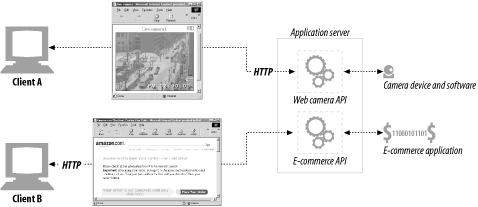Resource Gateways
So far, we’ve been talking about gateways that connect clients and servers across a network. However, the most common form of gateway, the application server, combines the destination server and gateway into a single server. Application servers are server-side gateways that speak HTTP with the client and connect to an application program on the server side (see Figure 8-8).

Figure 8-8. An application server connects HTTP clients to arbitrary backend applications
In Figure 8-8, two clients are connecting to an application server using HTTP. But, instead of sending back files from the server, the application server passes the requests through a gateway application programming interface (API) to applications running on the server:
Client A’s request is received and, based on the URI, is sent through an API to a digital camera application. The resulting camera image is bundled up into an HTTP response message and sent back to the client, for display in the client’s browser.
Client B’s URI is for an e-commerce application. Client B’s requests are sent through the server gateway API to the e-commerce software, and the results are sent back to the browser. The e-commerce software interacts with the client, walking the user through a sequence of HTML pages to complete a purchase.
The first popular API for application gateways was the Common Gateway Interface (CGI). CGI ...
Get HTTP: The Definitive Guide now with the O’Reilly learning platform.
O’Reilly members experience books, live events, courses curated by job role, and more from O’Reilly and nearly 200 top publishers.

